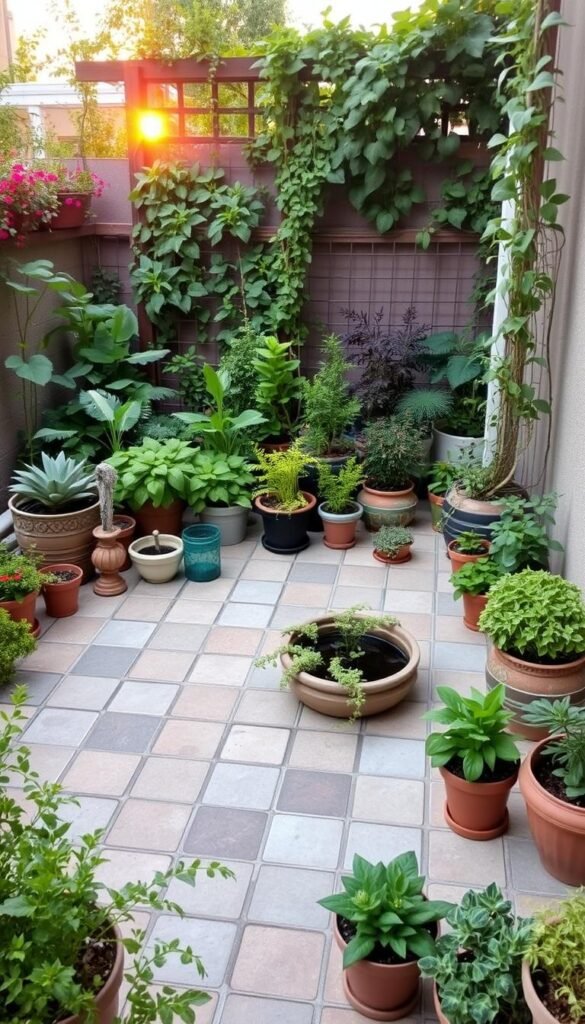Your outdoor area holds more possibilities than you might think. Whether you’re working with narrow urban backyards or cozy patios, smart planning can transform even 400 square feet into a lush retreat. As designer Karen Chapman notes, “Beauty and practicality flourish when you focus on what matters most to your lifestyle.”
Start by envisioning how you want to use your space. Would you rather host summer gatherings or grow fresh herbs? Maybe you crave a quiet corner for morning coffee. These decisions shape every element – from plant selection to seating arrangements. Elevate your space with smart design choices that balance form and function.
Vertical solutions like wall planters and tiered containers prove invaluable in tight spots. They add visual depth while maximizing growing areas. Strategic grouping of plants with similar needs simplifies maintenance, letting you enjoy greenery without constant upkeep.
Remember: successful transformations begin with a clear vision. Sketch your ideas using simple tools like graph paper or free apps. Mark pathways, focal points, and sunny zones. This roadmap helps create cohesive environments where every element serves a purpose – turning constrained quarters into personalized sanctuaries.
Designing a Compact Outdoor Sanctuary
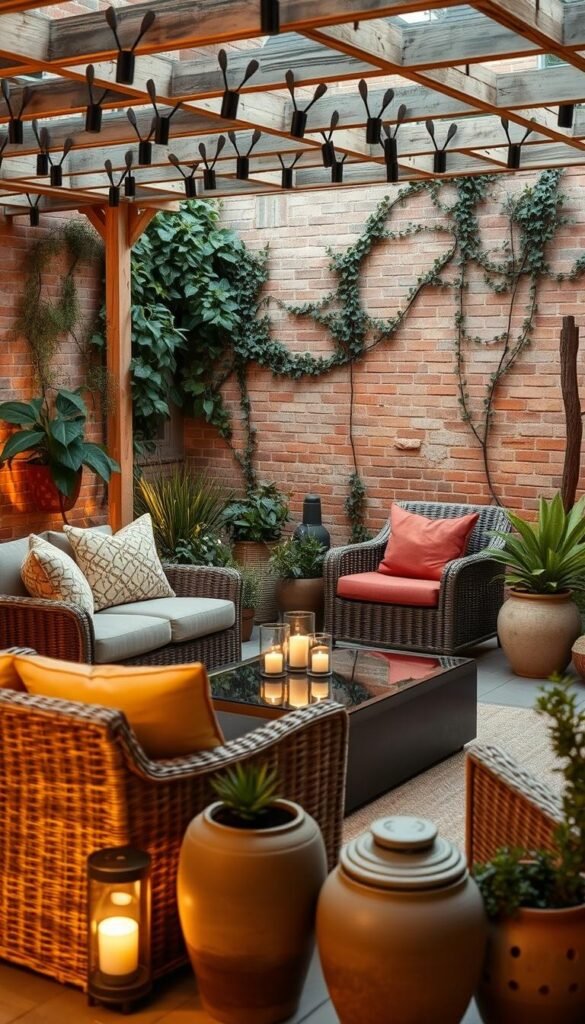
Maximizing your patio’s potential begins with clear priorities. Landscape architect David Stevens reminds us: “Every square foot in tight areas should earn its keep through beauty and purpose.” Start by measuring your exact dimensions – a tape measure reveals what’s truly possible.
Understanding Your Space Limitations
Ask yourself: Will Friday night dinners host four friends or twelve? Do fresh tomatoes matter more than cut flowers? These answers shape your layout. Foldable chairs tuck under narrow ledges, while extendable tables adapt to different group sizes. Built-in benches along retaining walls (17″ height works best) pull double duty as planters and seating when cushioned.
Embracing Versatile Garden Elements
Choose features that multitask harder than a Swiss Army knife. Gas fire tables glow warmly during evening gatherings and serve as coffee surfaces by day. Opt for plants like dwarf hydrangeas that offer spring blooms, summer greenery, and autumn color. Sturdy side tables with lift-up lids hide gardening tools while providing extra surface space.
Remember: narrow zones thrive on vertical layers. Train climbing roses up trellises to save ground space. Use hanging baskets for herbs within arm’s reach. Your cozy retreat will feel spacious when every element serves two purposes or more.
Maximizing Vertical Space in Small Gardens
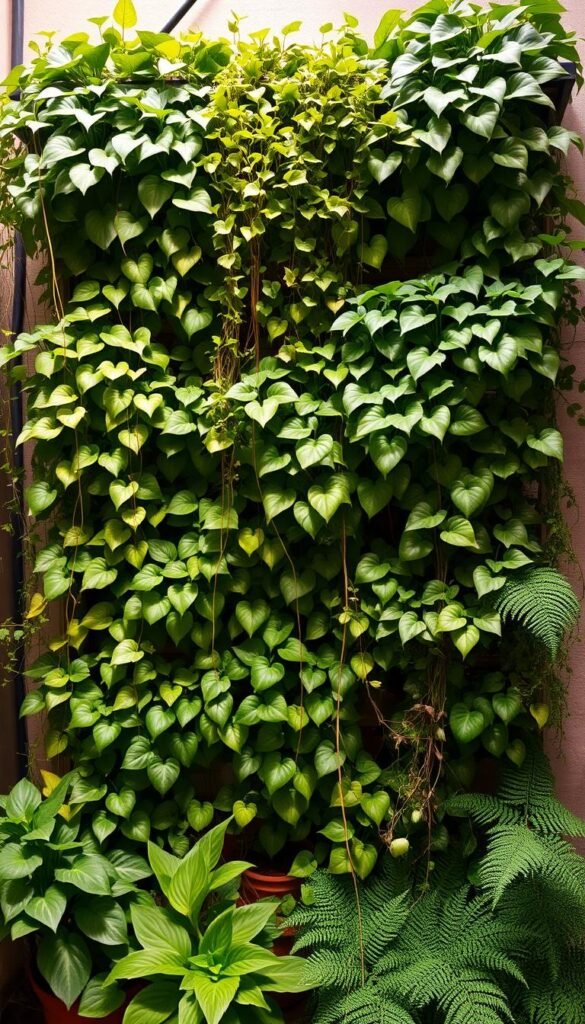
Reach new heights with vertical solutions that turn blank walls into thriving green spaces. Horticulturist Lisa Mason observes: “Growing upward triples usable area while adding depth to confined environments.” This approach lets you cultivate more greenery without sacrificing room for relaxation or movement.
Benefits of Vertical Gardening
Elevated planters and hanging baskets create breathing room below for chairs or stepping stones. Positioning foliage at staggered heights catches sunlight better – trailing vines bask in full rays while shade-loving ferns nestle beneath. You’ll notice fewer fungal issues too, as air moves freely through layered arrangements.
Choosing Plants for Height and Efficiency
Prioritize species that grow upward or spill gracefully. Edible options like cherry tomatoes thrive in pocket planters with trellis support. Fragrant herbs such as rosemary stay within reach when mounted at eye level. Consider these top performers:
| Plant Type | Sun Needs | Growth Pattern |
|---|---|---|
| Strawberries | 6+ hours | Cascading |
| Lettuce Mix | Partial shade | Compact clusters |
| English Ivy | Low light | Vertical climber |
Combine textures for visual impact – pair feathery ferns with bold-leaved pothos. Remember: lightweight soil mixes prevent wall strain, and drip irrigation systems simplify watering routines. Your living wall becomes both practical and eye-catching when planned thoughtfully.
Small Garden Design Ideas Layout: Strategies for Compact Spaces
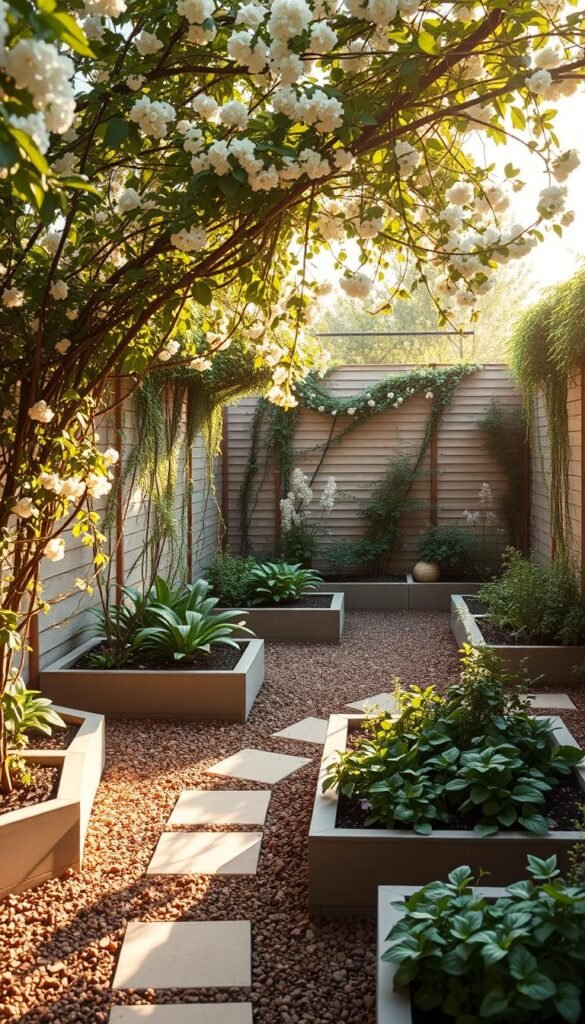
Transform your limited outdoor area into a functional oasis through clever spatial planning. The secret lies in balancing greenery with usable zones while creating depth illusions. Landscape designer Maria Sanchez advises: “Plant choices and placement patterns determine whether a tight area feels cramped or curated.”
Key Layout Strategies
Start by choosing plants that grow upward instead of outward. Columnar evergreens like ‘Sky Pencil’ holly add height without hogging ground space. Pair them with trailing nasturtiums in elevated planters – you’ll enjoy flowers and edible leaves without clutter.
Try angling walkways and beds diagonally across your plot. This 45-degree trick makes rectangular areas appear deeper. A curved gravel path leading to a corner bench stretches visual boundaries naturally.
| Strategy | Space Benefit | Plant Example |
|---|---|---|
| Vertical Layers | Frees floor space | Climbing hydrangea |
| Color Blocking | Enhances depth | Purple sage |
| Multi-Level Planters | Increases capacity | Dwarf citrus trees |
Use foliage plants as your base – heucheras with burgundy leaves or silver dusty millers work beautifully. Add seasonal blooms in movable containers for flexible color pops. Defined edges with boxwood hedges or stone borders keep the look tidy.
Remember: straight pathways create order, while gentle curves guide the eye. Mix both styles to balance structure with organic flow. Your thoughtfully arranged retreat will feel twice its actual size.
Innovative Container and Pocket Gardening Techniques
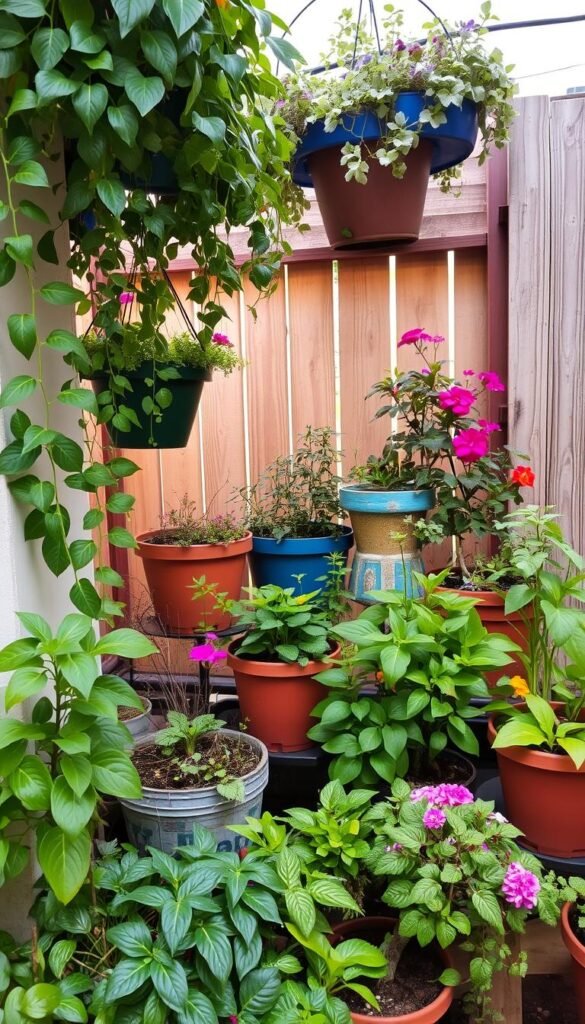
Unconventional planting solutions breathe new life into tight quarters. Landscape artist Emma Carter puts it perfectly: “The most memorable green spaces often grow from unexpected vessels.” This approach lets you cultivate personality alongside your plants.
Creative Container Options Beyond Traditional Pots
Turn household items into conversation starters. Rain boots overflow with petunias, while vintage colanders host basil within arm’s reach. Upcycled drawers become cascading strawberry planters when lined with burlap. For vertical impact, mount mason jars on sunny walls for succulents.
Arrange your containers like a pro:
| Shape | Best Location | Space Saved |
|---|---|---|
| Rectangular | Against walls | 40% more floor area |
| Oval | Railings | 28% width reduction |
| Triangular | Corners | Fills dead zones |
Group planters in odd-numbered clusters on tiered shelves. Three ceramic pots might hold rosemary, thyme, and oregano – practical and aromatic.
Utilizing Hidden Nooks and Crannies
Transform overlooked spots into micro-gardens. That 6-inch gap beside your garage? Perfect for tall, narrow planters of chives. Stair landings become herb stations with shallow troughs. Even AC unit side spaces work for shade-loving ferns.
Pro tip: Add casters to large containers. You’ll easily shift sun-loving plants across your patio while creating movable privacy screens. One wheeled planter can define different zones throughout the day – breakfast nook by morning, cocktail corner by dusk.
Remember: depth matters more than width in confined areas. Slim elliptical pots along railings leave walking room intact. Your hidden gardens become delightful surprises that maximize every inch.
Square Foot, Spiral, and Tiered Garden Approaches
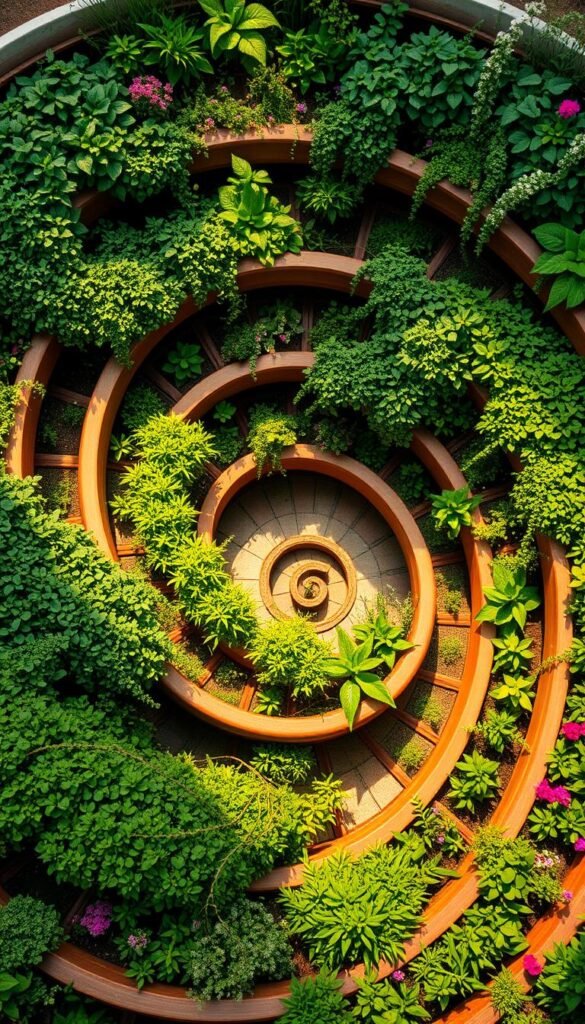
Transform your growing potential with space-smart systems that multiply yields while adding visual intrigue. These three methods turn limited areas into productive ecosystems through intelligent organization and vertical layering.
Organizing with Square Foot Gardening
This method turns a 4×4-foot raised bed into a geometric powerhouse. Divided into sixteen 1-foot squares using string or wooden slats, each section hosts specific quantities:
| Plant | Quantity/Square | Depth Requirement |
|---|---|---|
| Tomatoes | 1 | 8 inches |
| Lettuce | 4 | 6 inches |
| Radishes | 16 | 4 inches |
You’ll triple harvests compared to traditional rows while reducing weed growth. Position beds near water sources for easy maintenance – perfect for urban growers wanting fresh vegetables without the sprawl.
Layering with Spiral and Tiered Designs
Spiral gardens create microclimates in 5-6 foot diameters. Start building yours with these steps:
- Stack stones clockwise from the center outward
- Fill lower coils with moisture-rich soil for mint
- Use well-draining mix at the top for rosemary
Tiered systems stack planting levels against walls using repurposed materials. Upper shelves host sun-loving peppers, while lower tiers shelter shade-tolerant greens. This approach lets you maximize your garden’s potential through vertical efficiency.
Both methods prove that limited ground space doesn’t mean limited harvests. Your herbs and vegetables will thrive in these thoughtfully structured environments.
Enhancing Functionality with Multi-Purpose Elements
Every inch counts when crafting an outdoor retreat that works as hard as it relaxes. Clever dual-purpose solutions let you host friends, grow plants, and store tools without clutter. Think of your patio as a Swiss Army knife – each element should serve multiple missions seamlessly.
Dual-Purpose Outdoor Furniture and Features
Your entertaining setup becomes space-savvy with foldable bistro sets that disappear against walls when not in use. Expandable tables adapt to different group sizes – intimate dinners for two stretch to seat eight with a simple pull. Low ottomans topped with weatherproof cushions moonlight as footrests, side tables, or impromptu seats during summer parties.
Smart Storage and Seating Solutions
Built-in benches along retaining walls (the magic 17-inch height!) transform into comfy seating with plush pads. Lift-up lids reveal hidden compartments for trowels, twine, and watering cans. Corner banquettes hugging boundaries save precious square footage while accommodating more guests than freestanding chairs.
Raised planters do double duty when their edges become casual perches. Line them with outdoor-grade foam for comfort during sunset chats. These clever tweaks help your outdoor area stay organized while maximizing every surface – proving that smart planning creates spaces that work harder than they look.

